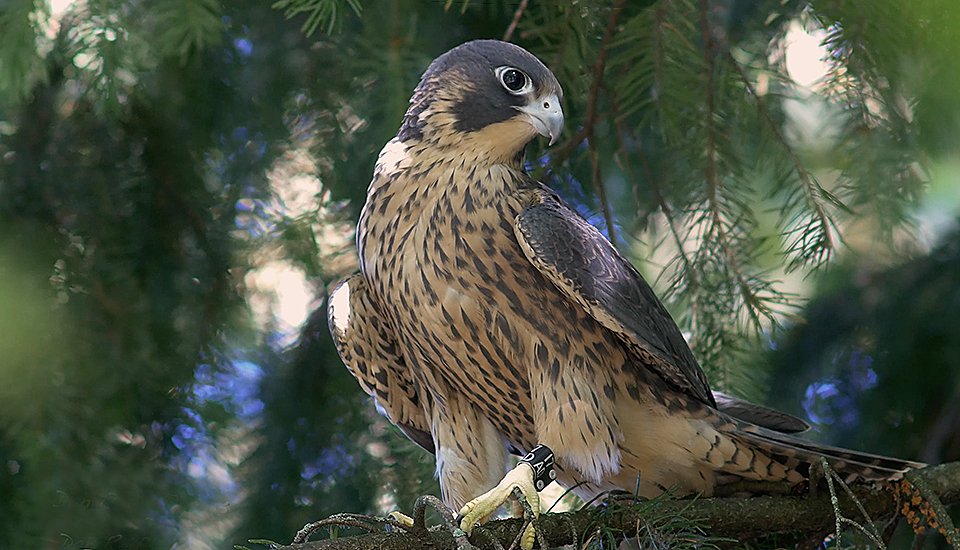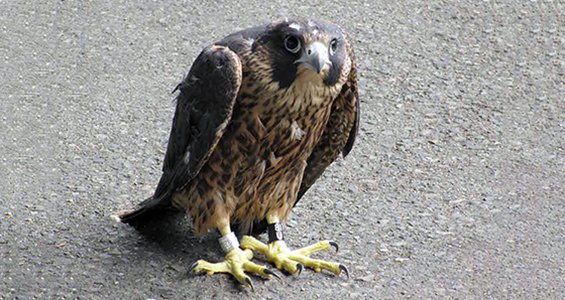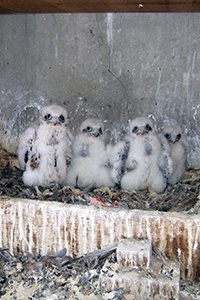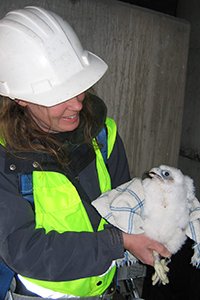1201 Falcon Cam
- Follow the 1201 3rd Ave falcon cam.
- Follow Wright Runstad on Twitter (@1201) for updates or to report a sighting.
- Report a sighting to URC
For more information
How a Seattle skyscraper became a refuge for falcons. Seattle Curbed (6/13/19).
Seattle Peregrine Project. Urban Raptor Conservancy.
Seattle Peregrines
Falco peregrinus

Juvenile Peregrine Falcon banded 17-AD on the day he fledged from Seattle’s I-90 Bridge in 2015. His first two nesting attempts, at the Ballard Bridge in 2017 and early 2018, both failed. In April 2018 he found a new mate near the I-5 and University Bridges, producing at least three young. The female died while the young were still in the nest, and 17-AD alone provisioned them until they fledged. The last Seattle Peregrine male observed to rear young alone was from the first pair to nest in Seattle, in 1994. Dan Reiff.
Urban History
The pesticide DDT nearly eliminated Peregrine Falcons. After DDT was banned in 1972, Peregrines were not seen in Seattle until winter 1990-1991, when an adult female established a winter territory in downtown Seattle centered on what was then Washington Mutual Tower, or WaMu, at 1201 Third Avenue. A group of Seattle school children named her Angeline, after Chief Sealth’s daughter. The next winter, another female established a territory at the I-5 Ship Canal Bridge and hence became known as Freeway.
Finally, in March 1994, two observers, Ruth Taylor and Ed Deal, independently discovered an adult male and a first-year female courting downtown on the WaMu building. They became the first breeding pair of Peregrines in Seattle in the post-DDT era.
By 1999, Peregrine Falcons had recovered to the extent that they were taken off the Endangered Species List. Peregrines had made a phenomenal comeback.
The First Nest: Stewart and Virginia
The downtown birds were named Stewart and Virginia, after downtown streets. Washington Mutual Bank and Wright Runstad & Company allowed Falcon Research Group to install a nestbox on a high ledge and focus a video camera on the birds. Stewart and Virginia laid eggs and became a media sensation. Viewers flocked to the lobby of the WaMu tower to watch them on a monitor, as they do now during
1994 was a rough season for this Peregrine family and their human followers. Virginia died after hitting a window when her three chicks were still tiny, and one chick died on the ledge at 3 weeks. However, thanks to a great deal of human intervention, including a temporary chick swap, single dad Stewart successfully fledged the other two young.

Bell with two-week old chicks.
Ruth Taylor.

This Juvenile Peregrine flunked flight school.
Ed Deal.
Stewart and Bell
In August 1994, a female in fresh adult plumage with a few remnant juvenile feathers appeared downtown and immediately formed a pair bond with Stewart. They nested successfully in 1995. This female, Bell, was a spectacular mother, fledging 26 young over the years. Her descendants now nest in and far beyond Seattle. After 11 years, Bell’s last nesting season was 2004. She died in July 2005, found by none other than Ruth Taylor, about two blocks from her home territory.
2018 was the 25th year of monitoring Peregrine Falcons nesting at 1201 Third Avenue by the Seattle Peregrine Project. Peregrines at this site have laid 84 eggs and hatched 66. Of these, 56 young were banded, 57 fledged, and 11 died within two months of fledging.
Where Did They Go?
By banding nestling Peregrines, we learn at least something of the birds’ fates after they disperse. Of the 56 banded offspring, six—four males, two females—were later found breeding elsewhere.
Female offspring that survive to breed typically disperse farther than males. Offspring from the 1201 nest certainly illustrate this. The four breeding males all favored bridges around Seattle and environs, while the two females went native: one nested on a cliff in the San Juan Islands and the other in the central Oregon Cascades.
What’s Next?
Besides the 1201 Third Avenue site, about five other active breeding sites in Seattle are now known, so far all on bridges. Breeding numbers of Peregrine Falcons in the city are probably limited by both the availability of nest sites and their own territoriality. Humans can sometimes help provide nest sites, but territoriality is as much a part of a Peregrine as its beauty. If the region’s Peregrine population increases, we may see serious conflicts over nest sites, as has occurred in other cities.
Freeway’s Story
In 1991-1992, an adult female claimed a winter territory in Seattle, only the second overwintering bird observed in decades. Her territory centered on the I-5 Ship Canal Bridge, so she was called Freeway. Bud Anderson of Falcon Research Group (FRG) trapped her and attached a VHF tail-mount transmitter. She led many FRG volunteers on merry chases through greater Seattle, giving insights into urban Peregrine behavior.
In March 1992, Freeway left on spring migration to her nesting territory , a chase team attempted to follow her. But her signal was lost as she was heading northwest over and likely beyond the San Juan Islands. Small plane searches by pilot and FRG volunteer Don McCall were unsuccessful at finding her.
Freeway returned to Seattle in September 1992, signal still beeping away. Soon afterward she molted the tail feather with
West Seattle Bridge

 In 1999, five years after the first pair of Seattle Peregrines nested downtown, a second pair was found at the West Seattle Bridge. Using a nestbox built by Martin Muller and installed by SDOT, the pair hatched young, but the nest was predated (probably by a Great Horned Owl). Both adults left the site.
In 1999, five years after the first pair of Seattle Peregrines nested downtown, a second pair was found at the West Seattle Bridge. Using a nestbox built by Martin Muller and installed by SDOT, the pair hatched young, but the nest was predated (probably by a Great Horned Owl). Both adults left the site.
Later, two females held that territory, but their intended mate probably had another nest elsewhere with his alpha female. No young. Finally, in 2005, the prevailing West Seattle female had a full-time mate. They reared four young and nested successfully again in 2006.
The West Seattle Bridge nest site continues to be successful. And in a nice case of symmetry, a West Seattle offspring now nests in Tacoma—and a graduate from the downtown Tacoma nest (see Tacoma Peregrines) now nests at the West Seattle Bridge.
The high-rise West Seattle Bridge closed abruptly in March 2020 and will remain closed through at least 2021. The future of the bridge, and hence of this nest site, is highly uncertain. Photos: Ed Deal.